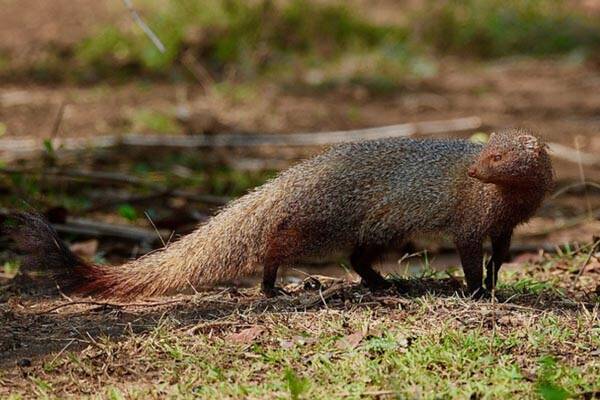Herpestes smithii
IUCN
LCBasic Information
Scientific classification
- name:Herpestes smithii
- Scientific Name:Herpestes smithii,Ruddy Mongoose,Red mongoose, Golden palm civet
- Outline:Carnivora
- Family:Meerkat
Vital signs
- length:40-45cm
- Weight:1.2-2.2kg
- lifetime:About 12 years
Feature
The fur is reddish brown and rough, and the tail ends in black.
Distribution and Habitat
Distributed in India, Nepal and Sri Lanka.
It inhabits open forests, including dry forests, dry thorn areas and disturbed forests. It has also been recorded in secluded rice paddies and relatively open fields, but in smaller numbers. The species has a wide geographical distribution, from arid areas of northern and western plains of India to high altitudes in southern India and in a variety of vegetation types in human-dominated agricultural landscapes. The elevation range in southern India is 50-2,200 meters.
Appearance
The mongoose has a coarse reddish-brown coat, with a long hindquarters and a shorter body. The head and body are 40-45 cm long, with a tail length of 36 cm. Males are larger and heavier than females, weighing 2.2 kg; females weigh about 1.2 kg. The tail accounts for about 75-90% of the body length. The mongoose is very closely related to the Indian gray mongoose, but the mongoose is slightly larger and has a black tail that ends in black and extends 5-8 cm.
Details
Ruddy Mongoose (scientific name: Herpestes smithii) is called "mugatiya" in Sinhalese in Sri Lanka. It is generally considered an untamable animal and a pest. This animal is a mongoose species endemic to Sri Lanka. It is also called "barrel" (hotambuwa) because of its appearance and color.

Red mongooses are primarily forest-dwelling animals, preferring isolated locations. They hunt both during the day and at night, like other mongooses. They climb trees at least occasionally, but apparently spend most of their time on the ground.
Listed by the IUCN as Least Concern due to its widespread distribution, high abundance, and the fact that it is unlikely to decline at a rate approaching that required to qualify for listing in the Threatened category. The impacts of habitat loss and degradation and hunting on the population are unknown, but it is unlikely that the population is declining at a rate sufficient to warrant Near Threatened status. Not only is the species geographically widespread, but it also occurs in a variety of vegetation types from arid regions of the plains of northern and western India to high altitudes (above 2000 m) in southern India and in human-dominated agricultural landscapes. Global populations of the red mongoose do not appear to be under significant threats, including from hunting and trapping by local tribes.
Listed in the IUCN Red List of Threatened Species (IUCN) 2015 ver3.1 - Least Concern (LC).
Listed in Appendix I, Appendix II and Appendix III of the Convention on International Trade in Endangered Species of Wild Fauna and Flora (CITES) in 2019 Level III.
Protect wild animals and eliminate game.
Maintaining ecological balance is everyone's responsibility!








